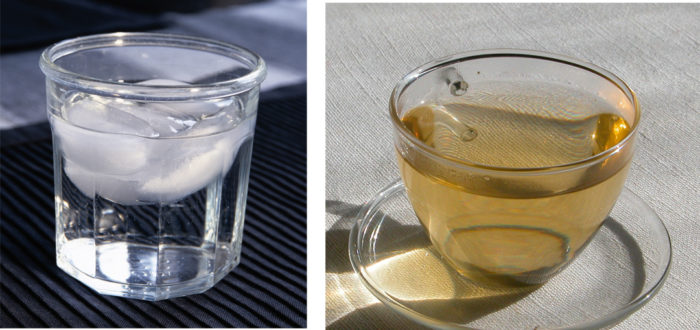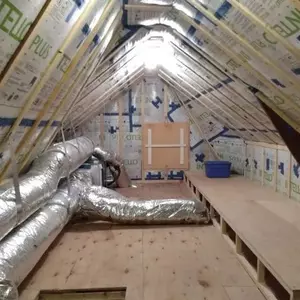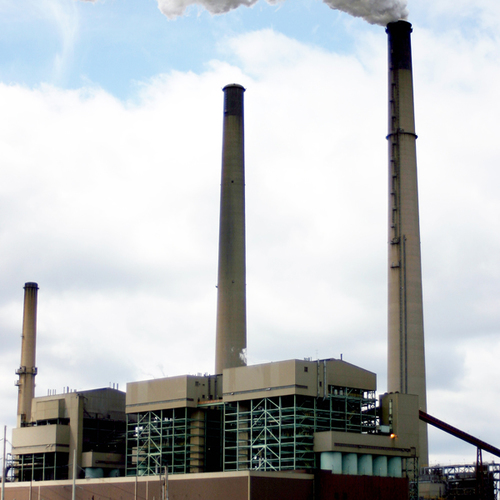
There are many measures used to evaluate building energy efficiency: total kBtu, kBtu/sq. ft./year, kWh/year, therms/year, kWh/sq. m./year, $/year, kBtu/person — and more. But determining when to use which metric, and even more importantly, how to make sense of a comparison of the energy efficiency of two different buildings, is no easy task.
Two glasses of liquid
Let’s use two glasses of water as an example. Some comparisons seem black and white – such as the question of which of the two cups of water sitting in front of us is hotter. Obviously the one that burns your finger is hotter than the one with the ice cubes floating around the rim.
But the comparison becomes much more difficult when we start looking at which building performs better. Not only is there much more information required in making this decision, there is also the question of how you look at the numbers.
Lots of variables
Let’s return to the example of the two cups of water. Our first question was pretty easy, but now let us look at the question of which cup of water requires less energy to maintain a temperature of 90°F.
Weekly Newsletter
Get building science and energy efficiency advice, plus special offers, in your inbox.
At this point quite a few more variables come into play. First, how much water is in the cup? If one cup has more water, it will require much more energy to maintain its temperature.
Second, what type of cup is the water held in: glass, plastic, ceramic, or maybe a covered, insulated coffee mug?
Third, how are the cups being heated — maybe one is being heated efficiently in the microwave, while another is being held over an open campfire. The cup over the open campfire will require much more energy to be used to keep it at temperature because the heating source is extremely inefficient.
Another consideration might be: Where are the cups sitting while not being actively heated? If one cup is sitting on a sunny window ledge while another sits in a dark closet, it would make a dramatic difference.
These are simple examples of the types of questions that have to be dealt with when measuring buildings and their energy performance, though building variables are even more varied and complex.
Making sense of the numbers
Now let us look at the second challenge: How to make sense of the numbers.
The best way to look at energy utilization is to have an actual measured number for the amount of energy used during a defined period of time. For a building, this would be the total BTU or kWh used by all energy sources for a year, though in our example of the two cups of water this would likely be in BTU per hour.
As an example, let’s say that Cup #1 required 100 BTU/h to maintain its temperature, while Cup #2 used 150 BTU/h to maintain the same temperature. At first glance, you would say that Cup #1 was more energy-efficient.
But here is where it gets complicated. What if Cup #1 contained only 10 ounces of water, while Cup #2 contained 30 ounces of water? In that case, Cup #1 requires 10 BTU/h/ounce, while Cup #2 requires 5 BTU/h/ounce.
Looking at the numbers this way, it seems as if Cup #2 is more energy-efficient. So what really is the standard that we should be using?
When looking at buildings, what really makes sense?
A solution?
I don’t have a definitive answer. The purpose of this discussion is not to decide on a unit of energy measurement that should always be used, but to outline the inherent challenges in comparing these metrics.
Trying to understand how one building compares to anther in terms of energy usage is an enormous task, and different answers emerge based on how the numbers are manipulated and reported. Making it easier to make sense of building energy statistics is a challenge that needs to be addressed if we want to change the status quo and move toward increasing the stock of net-zero energy buildings.
Do you have a suggestion? Please comment below.
________________________________________________________________________
Bill Maclay is the founder and president of Maclay Architects in Waitsfield, Vermont. His firm specializes in designing buildings and communities that are models for healthy, inspired living, advancing to a carbon neutral and ecologically sustainable future. Bill is the author of The New Net Zero: Leading Edge Design and Construction of Homes and Buildings for a Renewable Energy Future.















10 Comments
mass is a red herring
While the mass in the cup (or house) changes the amount of heat energy available to lose (and therefore the rate at which the temperature changes), it does not have any affect on the total energy. To maintain a constant temperature, the amount of heat added needs to equal the amount of heat lost. So the heat rate should be the number you care about for efficiency (BTU/hr). Or to make it independent of the outside and inside temperatures BTU/hr/deg.
start small
My experience is that a very small percentage of architects, builders, and remodelers make any effort at all to measure the energy usage of their projects. So we're not really ready for the conversation you hope to get started -- too many of us don't have the information or ability to put together even one of your proposed metrics, let alone decide among them. I think it's a safe bet that many readers have no idea what the KBtu/sf/yr of their own house is.
I'd love to see GBA require that any project that gets featured on its site note its KBtu/sf/yr for the most recent year of operations. I think that's a good, relatively simple place to start (imperfect as that metric is).
Full disclosure: up until this past May my own house used 38 KBtu/sf/yr -- not something I'm proud of. For context, I have gas heat, hot water, and clothes dryer; the rest is electric (no wood, oil, or propane).
Cost of PV has come down enough that it made sense to put some panels on even my suboptimal roof this past spring, so next May at this time (after a year's worth of production from our 18-panel array) I should be down to about 32 KBtu/sf/yr.
These numbers are site energy, not source energy (another topic you might want to cover at some point, Bill).
Energy Metrics-BSC's Take
FYI, here's BSC's take on Energy Metrics: BSD-152: Building Energy Performance Metrics (http://www.buildingscience.com/documents/digests/bsd152-building-energy-performance-metrics/)
My 2 Lincolns
I like BTUs per Conditioned Cubic Feet per Seasonal Heating Degree Days.
The BTU usage is whatever would be needed to maintain the indoor temperature at say 68 deg. F throughout the heating season of that HDD.
Adjust the equation to put the decimal point in a convenient place, use metric, use cooling degree days, etc.
This equation adjusts for size of house (regardless of floor plan and ceiling type) and local climate. I think it allows a better comparison between various buildings for energy usage and efficiency across a range of climate conditions. I know it doesn't account for sunny vs cloudy years, wind conditions, etc.
Keep it simple...letter grades.
To get 'normal' people to 'get it', use a letter grade system from A to F, and make it part of real estate transactions and put it in Zillow/etc. Most folks are (no disrespect) innumerate. When a hamburger chain introduced a 'third pounder' hamburger for roughly the same price as the quarter pounder, it didn't sell because many people though it was smaller (3<4)!
For techies, I always liked BTU(site output,heating)/sq.ft*HDD, also known as the Home Heating Index HHI, to quantify the envelope thermal performance. 1 is passive house, 2 is PGH, 5-8 is current code, 10 is legacy median, etc.
I would give all buyers two letter grades: one for 'energy efficiency', the other for 'energy cost'.
Both letter grades are computed from percentiles from houses in that region (like real grades in a class), the efficiency grade would be keyed to percentile HHI, the cost grade to percentile annual heating/cooling energy cost (depending on region).
Examples: getting a B+ on efficiency and a D+ on cost....probably a nicely sealed and insulated house with a legacy oil boiler....maybe the PO will be more likely to change to gas heat or HP before selling? Another house gets a C+ on efficiency and an B+ on cost....prob a drafty old barn with a gas furnace....new owner knows he should so some airsealing work.
What about appliances?? I think it matters much less at resale, because it comes down to personal usage habits, and folks can change them more easily after purchase.
Efficient lighting
I like Btu/sf/hdd, quite easy to calculate, adjusts for regional climate and year to year temperature fluctuations.
Efficient lighting has helped me more accurately flesh out the true heating load. If both electricity and gas are metered it is quite easy to isolate the heating portion of the gas bill by taking meter readings in June. July and August. The average of these by 12 is the annual non heating portion of the gas bill. I found as we replaced standard incandescent lights with CFL and now LED, the electrical consumption dropped and the gas consumption was up slightly. Better to heat with gas than standard light bulbs, if one pays close attention to monthly meter readings you will notice a slight change when lighting is upgraded.
Building Energy Statistics, Comparisons
Bill, Thanks for the blog on energy efficiency comparisons. Some thoughts:
a) Yes, there are a lot of variables. For such cases multiple 'yard sticks' are often useful.
b) Most of my comparisons are past vs. present in my one house. That way issues of size, climate, thermostat, et al are 'normalized'. Still, comparisons to other houses gives me perspective. The process is often called BENCHMARKING.
c) Regional comparisons are most useful to me. In our case, the Chicago area.
d) I use Degree Days for normalization. I think I should also use humidity but I currently don't track it.
e) Most of my interest is the efficiency of the house itself. For comparisons to other houses, I like to look at usage during mild weather when neither heat nor cooling are active. This identifies the "base" usage for things like appliances, lighting, and entertainment. Whatever that number is, we can work on it separately. We can then look at how the house responds to hot and cold weather. For dissimilar regions, the Degree Day normalization helps some. (This approach parallels Mr. McEvers' method to identify non-heating gas usage).
f) I'd prefer to see comparisons on the home only. If PV or Wind is involved, it can be viewed separately.
g) Following Mr. Eldrenkamp's lead, we (site) used 55.9 kBtu/yr/ft2 in 2001. We were just above average compared to our neighbors who are not very energy efficiency aware. By 2013, our usage was 33.6 kBtu/yr/ft2 and say 4.2kBtu/yr/ft3. Our house is late 80s vintage. We have gas heat, water, clothes dryer and no alternative fuels, PV, or Wind. We have a mostly finished basement but the ft2 are not counted in these numbers. (Also, using Mr. Crocker's method, we are currently at 5 Btu/heating degree day/ft2. We perform best in the summers, however.)
h) Whatever yard stick(s) are used, the search to me is for improvement. Let's say we have those comparisons. Then what? For me, I'd want to know HOW the top performers are achieving their results. This is where BEST PRACTICES comes in. It's the idea of sharing how it's done. That's one of my favorite things about GBA: the staff and the readers contribute their lessons learned and best practices and projects either for new construction or upgrading existing. My projects are all of the upgrading type.
metrics
I recently did the math on my home after about 5 years of steady upgrades copied here:
Annually, I am using 64 MCF of natural gas and 4,200 kWh and your square footage is 2,141 ft2.
For Natural Gas (which is really kCF – don’t ask, it’s a gas company issue, Mcf = 1,000; Mmcf = 1,000,000):
64 kCF * (1,028 Btu / CF) = 65,792 kBTU
For Electricity:
4,200 kWH * ( 3.412 kBTU/kWh ) = 14,330.4 kBTU
Thus, my non-weather adjusted residential EUI for the 12 months (use has been very steady last 3 years) is:
(65,600 kBTU + 14,330.4 kBTU ) / 2,141 ft2 = 37.3 kBTU/ ft2, which is ~13% below the single family 2009 national median of 42.8, but still almost 8 times the Passive House EUI of 4.73.
These calculations use EPA’s thermal conversion factors: http://www.energystar.gov/buildings/tools-and-resources/portfolio-manager-technical-reference-thermal-conversion-factors.
I was disappointed to see that I was not doing better against the 2009 median. I know our power use is low compared to all the neighbors since we rarely use AC. What I do not like is the conversion math; I think every household should know their kwh/year and mcf/year or whatever units the bill shows you. That is so easy to access and share and keeps the two sources separate. In terms of dollars, we are at $10/mcf and $0.13/kwh or about $1186/yr total gas and power. So if I am 8 times worse than Passive House then a PH of same size spends only $148/yr.
Is there a PH owner out there with 2100 sf and $148/yr costs?
rating
The department of Energy has a program that is trying to give home a uniform energy score, it think it is a 1-10 scale. Ideally it will become as well understood as cars and mpg, we all can figure that out and know that the numbers depend on the user and other factors. I don't think there is a perfect method that will make everyone happy, big houses vs small houses, primary vs second homes, cold vs warm climates. Not a simple question.
Great discussion
Our goal was to open a constructive dialogue, which I’m pleased is what resulted – Thank you for your thoughtful comments.
Our opinion is that the calculation of energy use intensity (EUI) for all buildings is the best strategy. This is simply calculating all energy consumed on site and dividing by the building size. While this process has its challenges, we think a simple and easy metrics is critical and as of today, in our opinion, this is the best way to do this.
For further information please see our recent blog post that goes into greater detail at the following link.
http://www.netzeroenergyvt.net/2014/09/getting-to-net-zero-fuel-mileage-for-buildings/
Log in or create an account to post a comment.
Sign up Log in